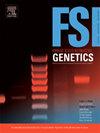Point-of-need species identification using non-PCR DNA-based approaches to combat wildlife crime
IF 3.1
2区 医学
Q2 GENETICS & HEREDITY
引用次数: 0
Abstract
Wildlife crime, defined as any unlawful exploitation and trade of wildlife, is a lucrative illegal global industry, along with narcotics and weapons trafficking. It encompasses the harvest, transport, exchange, and end use of wildlife or wildlife-derived products. Regulated internationally by the Convention on the International Trade in Endangered Species of Flora and Fauna (CITES, 1973), wildlife crime is primarily detected using morphological or DNA sequencing methods. However, there is a growing demand for rapid, portable, and cost-effective screening tools to bypass time-consuming workflows and specialist laboratory equipment. Point-of-need testing, particularly at wildlife hotspots like international borders, offers a promising solution for the swift detection of illegal activities. Isothermal amplification methods such as loop mediated isothermal amplification (LAMP), rolling circle amplification (RCA), and recombinase polymerase amplification (RPA), are favoured for their low resource needs compared to traditional PCR. These methods can be combined with target detection methods such as clustered regularly interspaced short palindromic repeats (CRISPR) and aptamers to enhance sensitivity. Integrating these methods with others, such as lateral flow assays (LFA) and microfluidic devices, simplifies sample preparation and visualisation. Already established in disease diagnosis and food safety, these innovations in genetic testing provide rapid, on-site detection. When applied to wildlife crime, they can serve as tools to complement traditional PCR and sequencing methods. This review explores how non-PCR based approaches could offer faster, simpler, and more cost-effective solutions to combat wildlife crime.
利用非聚合酶链反应dna方法进行定点物种鉴定,打击野生动物犯罪
野生动物犯罪,被定义为任何非法开采和交易野生动物,是一个利润丰厚的非法全球产业,与毒品和武器贩运一样。它包括野生动物或野生动物衍生产品的收获、运输、交换和最终使用。根据《濒危动植物种国际贸易公约》(CITES, 1973),野生动物犯罪主要通过形态学或DNA测序方法进行检测。然而,对快速、便携和具有成本效益的筛查工具的需求不断增长,以绕过耗时的工作流程和专业实验室设备。即时检测,特别是在国际边境等野生动物热点地区,为快速发现非法活动提供了一个有希望的解决方案。与传统PCR相比,环介导等温扩增(LAMP)、滚圈扩增(RCA)和重组酶聚合酶扩增(RPA)等等温扩增方法因其资源需求低而受到青睐。这些方法可以与聚类规则间隔短回文重复序列(CRISPR)和适体等靶标检测方法相结合,以提高灵敏度。将这些方法与其他方法(如横向流动分析(LFA)和微流体装置)集成,简化了样品制备和可视化。这些基因检测的创新已经在疾病诊断和食品安全方面建立起来,提供了快速的现场检测。当应用于野生动物犯罪时,它们可以作为传统PCR和测序方法的补充工具。本综述探讨了非pcr方法如何能够提供更快、更简单和更具成本效益的解决方案来打击野生动物犯罪。
本文章由计算机程序翻译,如有差异,请以英文原文为准。
求助全文
约1分钟内获得全文
求助全文
来源期刊
CiteScore
7.50
自引率
32.30%
发文量
132
审稿时长
11.3 weeks
期刊介绍:
Forensic Science International: Genetics is the premier journal in the field of Forensic Genetics. This branch of Forensic Science can be defined as the application of genetics to human and non-human material (in the sense of a science with the purpose of studying inherited characteristics for the analysis of inter- and intra-specific variations in populations) for the resolution of legal conflicts.
The scope of the journal includes:
Forensic applications of human polymorphism.
Testing of paternity and other family relationships, immigration cases, typing of biological stains and tissues from criminal casework, identification of human remains by DNA testing methodologies.
Description of human polymorphisms of forensic interest, with special interest in DNA polymorphisms.
Autosomal DNA polymorphisms, mini- and microsatellites (or short tandem repeats, STRs), single nucleotide polymorphisms (SNPs), X and Y chromosome polymorphisms, mtDNA polymorphisms, and any other type of DNA variation with potential forensic applications.
Non-human DNA polymorphisms for crime scene investigation.
Population genetics of human polymorphisms of forensic interest.
Population data, especially from DNA polymorphisms of interest for the solution of forensic problems.
DNA typing methodologies and strategies.
Biostatistical methods in forensic genetics.
Evaluation of DNA evidence in forensic problems (such as paternity or immigration cases, criminal casework, identification), classical and new statistical approaches.
Standards in forensic genetics.
Recommendations of regulatory bodies concerning methods, markers, interpretation or strategies or proposals for procedural or technical standards.
Quality control.
Quality control and quality assurance strategies, proficiency testing for DNA typing methodologies.
Criminal DNA databases.
Technical, legal and statistical issues.
General ethical and legal issues related to forensic genetics.

 求助内容:
求助内容: 应助结果提醒方式:
应助结果提醒方式:


